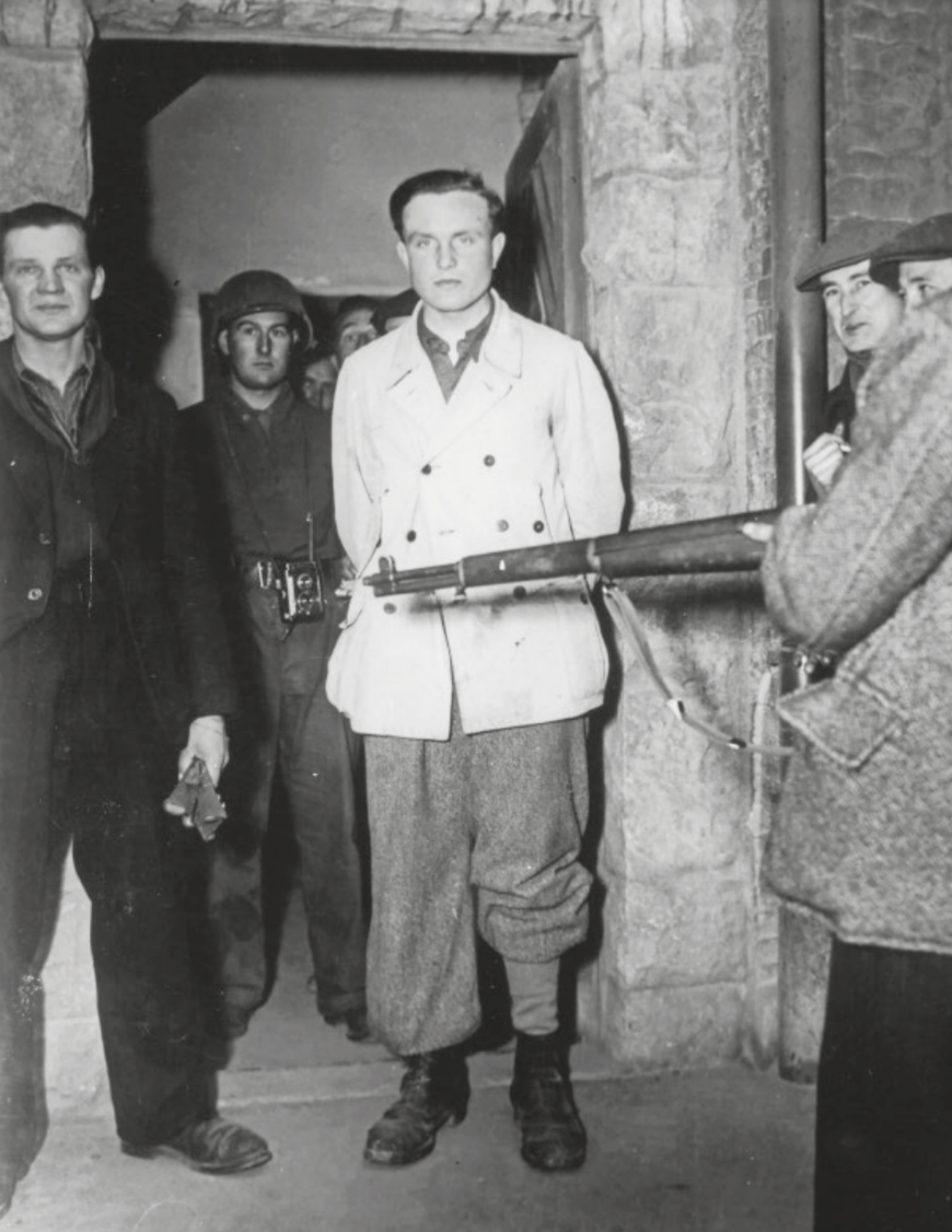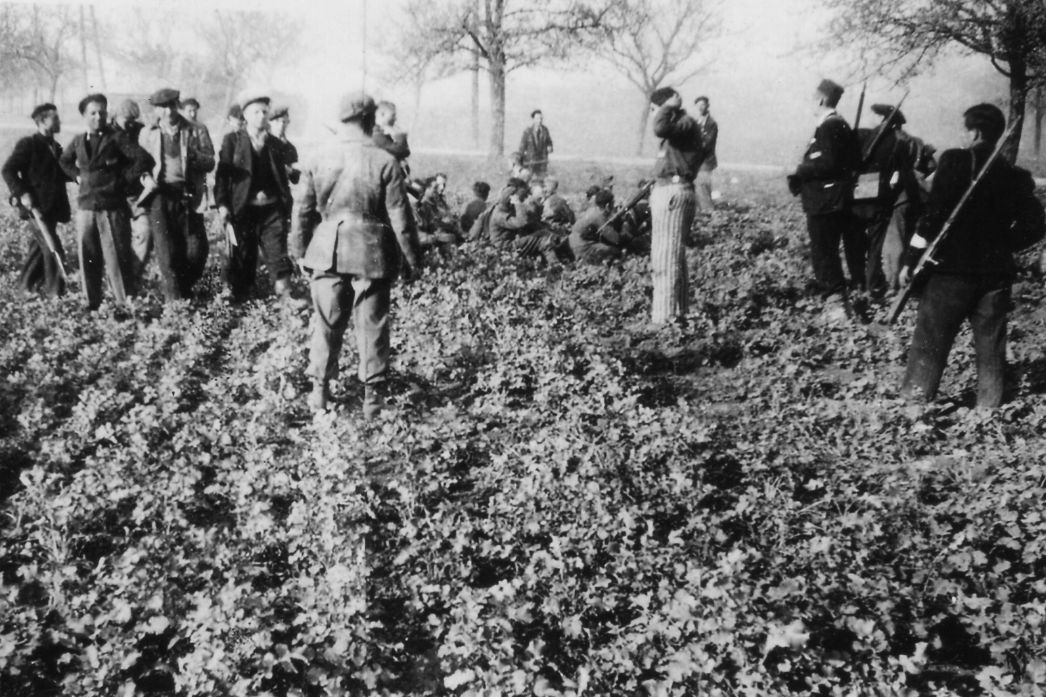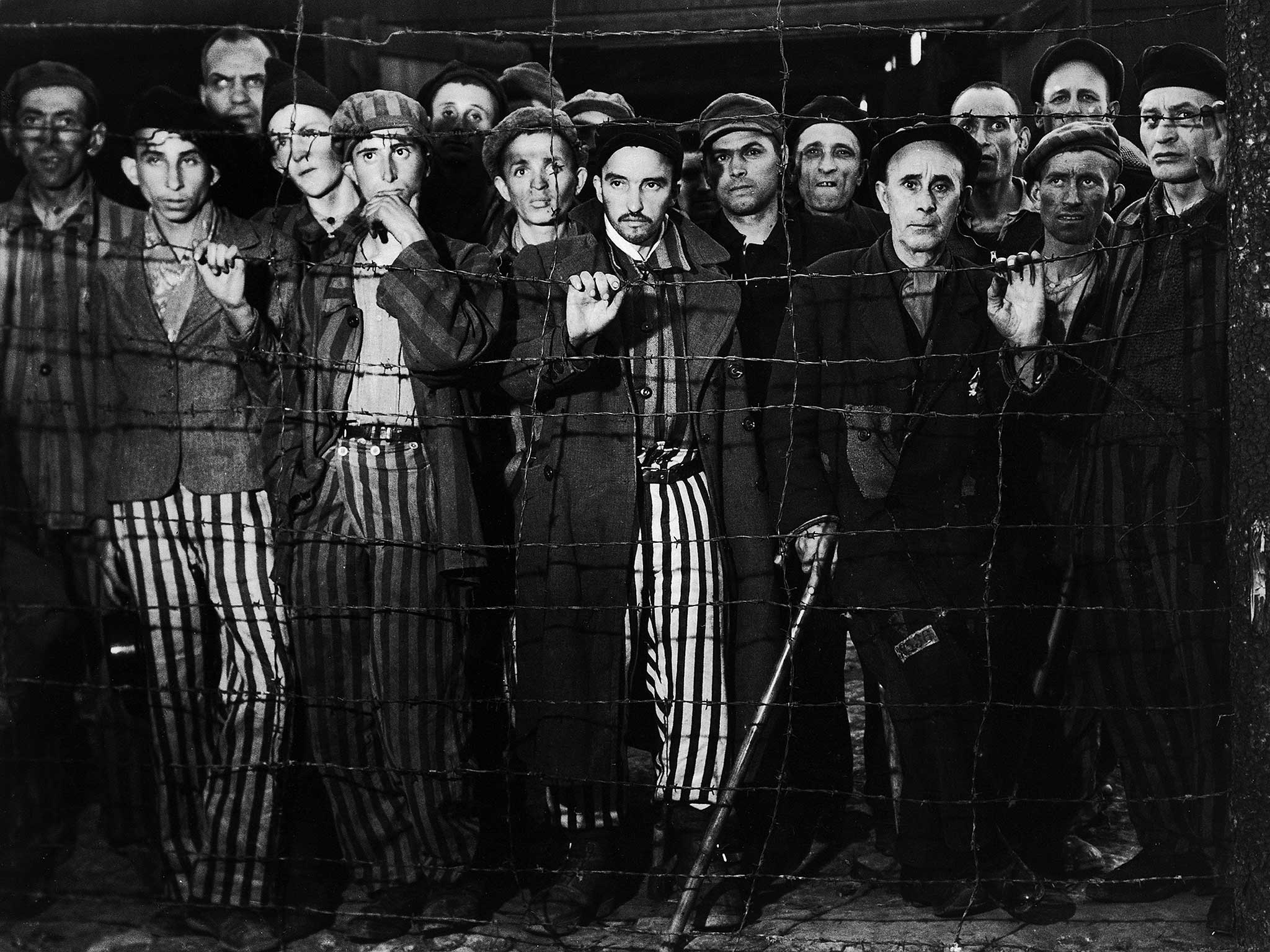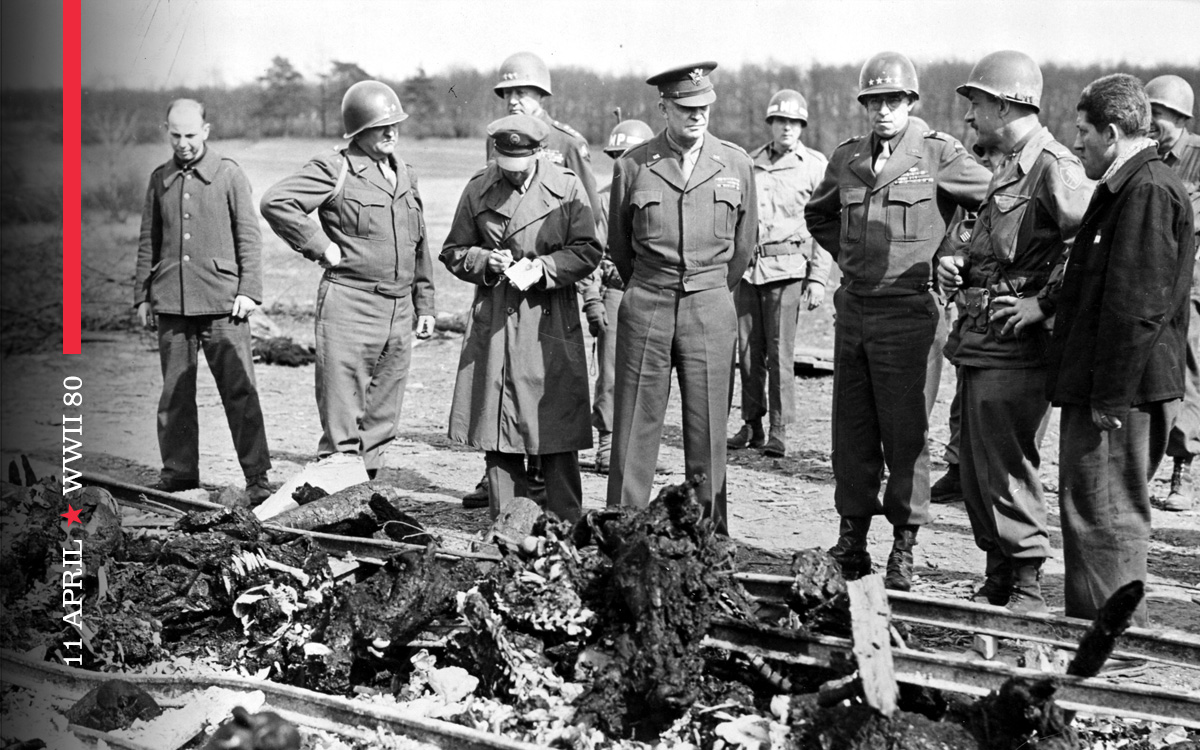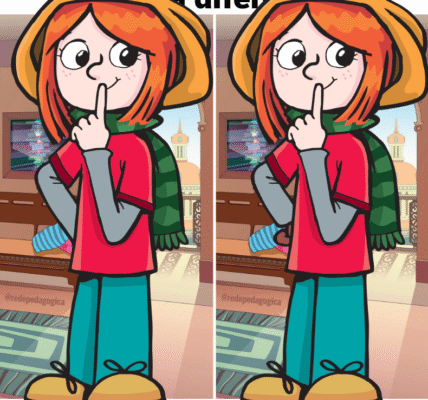The photograph is raw and unforgettable. Two men kneel on a hard concrete floor, their faces bruised and swollen, their eyes hollow yet defiant. Their lips are split, and blood clings stubbornly to their mouths. They wear plain clothes—civilian jackets, ill-fitting trousers—yet their presence does not blend into innocence. They are captives, kneeling not as victims of a regime but as the remnants of one.
The image was taken in Buchenwald concentration camp, April 1945, on the very day of liberation. The official description tells us these were camp guards who were captured and beaten by prisoners on the day the Americans arrived. But history is rarely that simple. Some accounts suggest they may not have been SS guards at all, but Kapos—prisoners themselves who had been given positions of authority by the SS to oversee, punish, and control their fellow inmates. In either case, the photograph embodies a rare and unsettling glimpse into that liminal moment: the hours between oppression and freedom, between vengeance and justice.
The Weight of Silence in a Photograph
Look at them closely. The man on the left, his jacket neatly buttoned despite the chaos, keeps his fists clenched by his side. His eyes seem to plead—not for forgiveness, but for recognition. The man on the right, his face more battered, appears dazed, his shirt undone, his body slouched forward as if surrendering to the weight of history.
The room itself is stark: a narrow corridor, painted walls, harsh lighting. It feels claustrophobic, a space too small to contain the enormity of what had just happened outside those walls. For outside, thousands of liberated prisoners stumbled toward freedom, their emaciated bodies moving forward with a mix of disbelief and exhaustion. The stench of death still hung in the air. Corpses lay in piles. Survivors clutched at life with trembling hands.
And somewhere in that sea of chaos, rage boiled over.
Who Were They—SS Guards or Kapos?
The truth of the men in the photograph may never be fully known. Were they SS guards attempting to escape justice by disguising themselves in civilian clothing, hoping to vanish into the exodus of the defeated Reich? Or were they Kapos, prisoners elevated to positions of power inside the camp, men who had been victims themselves, but who accepted—sometimes eagerly, sometimes reluctantly—the cruel privileges granted by the Nazis?
The ambiguity matters, because it reveals one of the most disturbing aspects of the Holocaust: the way the Nazis turned victims into instruments of their own oppression.
The Cruelty of the Kapo System
The Kapo system was one of the most diabolical inventions of the Nazi concentration camp structure. To conserve SS manpower, guards delegated control to prisoners who were willing to serve as overseers. In return, these Kapos received small privileges—extra food, warmer clothing, better sleeping quarters. But the true price was far greater: they were forced to brutalize their fellow inmates, to maintain order through violence, to become enforcers of terror inside the very cages that held them.
For the SS, this system achieved two aims. First, it reduced their need for manpower. Second, and more insidiously, it sowed division and distrust among the prisoners themselves. By pitting victims against victims, they stripped away solidarity, replacing it with suspicion and fear.
Not all Kapos abused their positions—some tried, in small ways, to shield fellow prisoners from the worst of the brutality. But many became infamous for their cruelty, beating fellow inmates with a zeal that rivaled their SS masters. These men, once fellow sufferers, became symbols of betrayal inside the camps.
Liberation and Reckoning
When the SS abandoned camps like Buchenwald in the final days of the war, they left behind chaos. Prisoners—starving, broken, yet unbowed—suddenly found themselves without the constant presence of armed guards. For the first time in years, the scales shifted. Power returned, if only briefly, to the hands of the oppressed.
And in those hours of liberation, something primal erupted.
Prisoners dragged suspected guards and Kapos into corners, into empty rooms, into the very spaces where they themselves had once been humiliated and beaten. Some were unmasked trying to escape. Others were remembered for their brutality.
The two men in the photograph had already been caught, already been beaten. Their swollen faces testify to that moment of reckoning.
Justice or Vengeance?
Here lies the most haunting question of all. Were these beatings acts of justice—or vengeance? Can we, who live decades later in relative safety, judge men who had suffered years of unimaginable cruelty?
It is tempting to think of liberation as pure joy—the gates thrown open, freedom pouring in like sunlight. But the truth is more complicated. Liberation was messy, painful, filled with grief and rage. Survivors stumbled out into freedom carrying the ashes of their families, the scars of starvation, the memories of torture. The war may have ended, but the wounds had not.
So when prisoners struck their former tormentors—whether SS or Kapo—was it cruelty, or was it the inevitable eruption of years of suppressed pain?
The Shadows of Betrayal
Perhaps the most tragic element of the Kapo system was the betrayal it represented. Imagine being imprisoned, stripped of everything—your family, your dignity, your freedom—and then discovering that the man who beat you into silence at roll call was once a prisoner just like you. Imagine seeing him eat a crust of bread while you starved, wear a warm coat while you shivered, strike you with a club to prove his loyalty to the SS.
It was a system designed to break not just bodies, but trust. And when liberation came, the memory of those betrayals did not vanish.
The Price of Survival
It is easy to condemn the Kapos, and many deserved condemnation. But it is also necessary to acknowledge the impossible choices they faced. Some accepted the role simply to survive another day. Some believed that by taking the position, they could protect others. Others succumbed to the corrupting lure of power in a place designed to strip power from all.
The photograph offers no answers. It merely shows us two men who had crossed a line—willingly or unwillingly—and who now faced the consequences.
Liberation Was Not the End
For the survivors of Buchenwald, liberation was only the beginning of another journey. They left the camp alive, but they carried invisible wounds. Many never spoke of what they endured. Others spoke, but their words could never fully capture the depth of suffering.
The image of the two beaten men is a reminder that the Holocaust did not end neatly. It did not close with a clean division between good and evil. It left behind blurred lines, gray zones, and unanswered questions.
A Story That Demands to Be Remembered
When we look at this photograph today, nearly eighty years later, it demands that we confront uncomfortable truths about human nature. It reminds us how systems of oppression manipulate, corrupt, and destroy trust. It forces us to wrestle with the messy aftermath of liberation—the rage, the vengeance, the desperate search for justice in a world shattered by cruelty.
Above all, it reminds us that history is not abstract. It is human. It is two men kneeling on a concrete floor in April 1945, their faces swollen, their eyes heavy with silence.
Conclusion: The Lingering Echo of Buchenwald
The liberation of Buchenwald concentration camp was a triumph of freedom over tyranny, but it was also a mirror reflecting the scars left behind. The Kapos, the guards, the prisoners—all were entangled in a web spun by cruelty. And when the web was torn apart, the aftermath was anything but simple.
We may never know exactly who those two men were. But perhaps that is not the point. Perhaps their story is not about identity, but about the shadows that remain when humanity is pushed to its breaking point.
The photograph leaves us unsettled, as it should. For the Holocaust was not only a story of evil inflicted from without, but also of the ways evil seeped within, corrupting bonds, distorting choices, and leaving survivors to navigate a world forever changed.
In the end, the men in the photograph are more than just two figures caught at a moment of reckoning. They are symbols of a history we must never forget—reminders that liberation, though glorious, came with shadows that will echo for generations.

